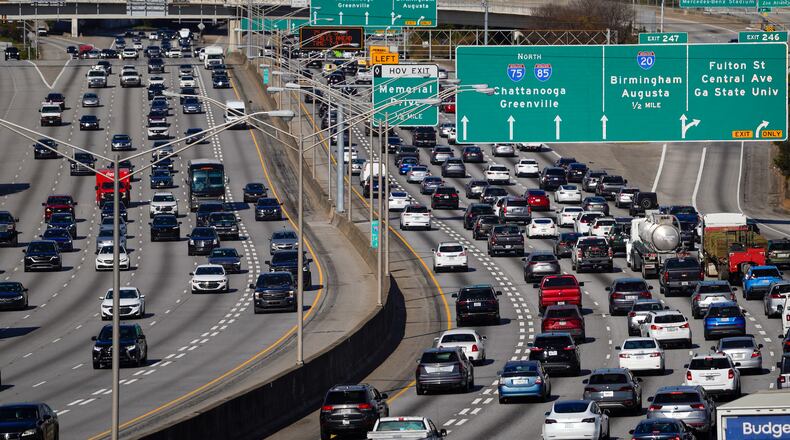If you live in metro Atlanta, dealing with traffic is in your DNA, but you’ve probably noticed a shift to more unpredictable travel patterns in recent years.
“Rush hour is actually rush five hours,” said Ronnie Beets, who runs Cupcakin’ Bake Shop in Midtown’s Colony Square and has been driving in the city for 10 years.
He said his 20-minute commute from Doraville regularly takes twice as long as he once expected: “It’s definitely worse than it used to be.”
He’s not wrong.
Credit: Rosana Hughes
Credit: Rosana Hughes
A recent study from Texas A&M University backs up what Beets and everyone else are seeing. Roads are clogged all day long, and by some metrics, traffic is indeed busier than in 2019.
The latest version of the annual Urban Mobility Report confirms that metro Atlanta’s traffic ramped back up to pre-pandemic levels in 2024 — the culmination of a slow return-to-office push after COVID-19 shuttered job sites and gave employees flexibility to work from home. Last year, the city saw six hours of congestion per day compared with roughly 4 ½ hours in 2019. In 2020, when the pandemic began, there was less than an hour.
Atlanta is tied with Chicago and Seattle for the 9th most-congested “very large” urban area, according to the report. In those three places, commuters spent an average of 87 hours in traffic last year. Los Angeles took first place, with motorists languishing for a whopping 137 hours in traffic in 2024.
While metro Atlanta congestion still peaks from 7-9 a.m. and 4-6 p.m., more flexible work schedules have led to increased midday traffic. Without that shift in driving patterns, it could be a truly horrendous evening commute, Kartik Jha, the report’s co-author, told The Atlanta Journal-Constitution.
For context, the region has added more than 300,000 people since 2020, according to the Atlanta Regional Commission.
Tamara Zaki lives not far from her job in Midtown, but her commute can still take up to 40 minutes, she said. It’s at least some consolation that commuters who drive midday are saving her from an even longer trip home.
“I guess I appreciate it?” she said with a chuckle. “I’m not usually leaving the office before 5 p.m., so thank you, everyone in Atlanta, for leaving a little bit earlier.”
A similar trend is playing out across the country. The report estimates that if workers’ morning and evening driving routines were as rigid as they were in 2019, there would be 300 million more hours wasted on roads annually all over the U.S.
“So it’s great, in a way, because what’s happening is that ... some of that delay is kind of getting absorbed during other parts of the day,” Jha said.
But the shift in habit also means that metro Atlanta’s only periods with free-flowing traffic are now the midnight and early pre-dawn hours, Jha said.
Another finding, also thanks to versatile work schedules, is that for the first time since researchers started compiling the report in 1987, Friday is no longer the nation’s heaviest-traveled day. That dubious honor now goes to Thursday for most of the country. In Atlanta, it’s Wednesday, Jha said. Tuesday is the city’s second-worst, followed by Thursday. (In 2023, Atlanta’s busiest days fell on Thursday and Friday.)
Even though Friday is still the day with the most cars on the road nationwide, the travel patterns look more like the weekend — with motorists driving on more surface streets and throughout the day, Jha said. That’s probably because of hybrid work schedules.
“Maybe (people) are working from a place other than the office on Friday, maybe they are even taking Fridays and Mondays off,” Jha said.
Other weekdays see a more typical commute pattern, which leads to heavier delays, especially in the evening. Across the board, Atlanta’s weekday traffic is at its absolute worst in the evening.
Weekend congestion is obviously much lower, but Saturdays see the most delays between 1-4 p.m.
The researchers’ findings don’t come as a surprise to the Georgia Department of Transportation.
“The Urban Mobility Report is relaying a reality that the department has been aware for quite some time due to population growth, commute trends and freight growth throughout the state,” said GDOT spokesperson Natalie Dale.
The agency works with the regional commission to develop long-range transportation plans to try to keep up with the influx of people moving to the area.
“There’s no one-size-fits-all solution to our region’s transportation challenge. Rather, a balanced approach is needed,” said Paul Donsky, commission spokesperson.
Both ARC and GDOT continue to look for novel solutions to help address the day-to-day traffic headaches, such as improved traffic signal coordination, officials said. But bigger efforts are needed to fix capacity issues.
Those types of projects include the reconstruction of the I-20/I-285 interchanges on both the Perimeter’s east and west sides and the addition of express lanes for Ga. 400 and the top end of I-285, Dale noted.
“We really don’t ever stop looking at solutions as our project modeling takes into account traffic growth for 10, 20, 30 years down the line,” she said.
In the meantime, many motorists, such as Amari Higgs, a food service worker in Midtown, have to add up to two hours to their morning routine just to make sure they get to work on time. She could once predict when to leave to beat rush hour, but that’s getting more difficult to do, she said.
Sometimes, she said, it feels “like I spent most of my time traveling to where I’m trying to go than actually being at where I need to be.”
Urban areas of more than one million people with the most hours annually of traffic delay per commuter
Los Angeles - 137 hours
San Francisco - 134 hours
New York - 99 hours
Riverside-San Bernardino, California - 95 hours
San Jose, California - 94 hours
Miami - 93 hours
Washington, DC - 90 hours
San Diego - 88 hours
Atlanta, Chicago, Seattle - 87 hours
Nashville - 83 hours
Source: Urban Mobility Report
About the Author
Keep Reading
The Latest
Featured


